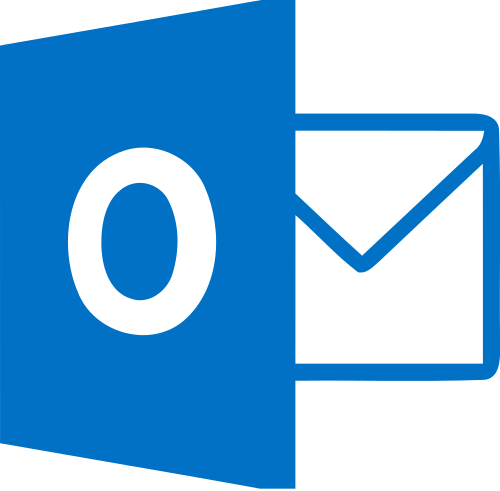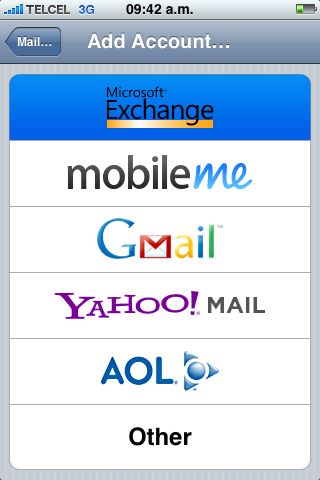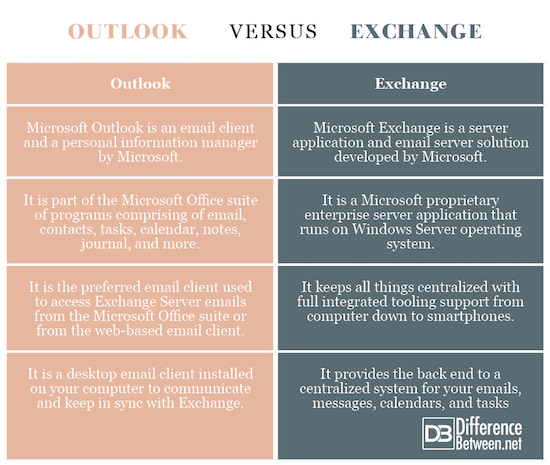Difference Between Outlook and Exchange
To better understand the difference between Outlook and Exchange, you must know the difference between an email client and a mail server. A mail server is a system that stores and manages your sent and received mails over a network, usually over the Internet. Think of a mail server as your friendly neighborhood deliveryman who receives emails from local users and reroutes them for delivery. A mail server sends and receives emails using standard email protocols such as IMAP and POP3 protocols. An email client is used for sending and receiving emails. For example, a webmail is an email client that is installed on a server and functions in almost any web browser. Microsoft Outlook is an email client and Exchange is a Microsoft proprietary email server and calendaring server.

What is Microsoft Outlook?
Microsoft Outlook is an email client used to send and receive electronic messages over a network using standard email protocols. It’s more like a software program which is more than just an email management application; in fact, it’s part of the Microsoft Office suite of software and programs which allow you to manage your emails, contacts, address book, tasks, calendar, all in one place. It is basically a desktop email client installed on your computer and is mainly used for email management and is designed to function as an independent personal information manager.

What is Microsoft Exchange?
Microsoft Exchange is an email server application and personal information management server that runs on Windows Server operating system. It is a software product developed by Microsoft designed to make emailing faster and more efficient. It is a Microsoft proprietary product comprises of Microsoft Outlook email client and Microsoft Exchange Server providing an integrated system to store and manage all your emails, messages, contacts, tasks, and more in a centralized database. Microsoft Exchange is also known as Windows Messaging. Simply put, it’s a software program that runs on a server and manages all your emails.
Difference between Outlook and Exchange
Basics of Outlook Verses Exchange
Microsoft Outlook is one of many email clients used to send and receive email messages over a network, usually the internet. Although it is often used as an email client, it is more than just an email application. It’s part of the Microsoft Office suite of proprietary software and programs which makes it easy to manage your emails, contacts, and calendar, and even social networks – all in one place. Microsoft Exchange is a Microsoft proprietary product that consists of the Microsoft Exchange Server and the Microsoft Outlook. It is simply an email server solution developed by Microsoft.
Purpose of Outlook verses Exchange
Basically, both the applications work together, one at the server side and the other at the client side. Microsoft Exchange is a software suite that operates on the server side providing the back end to a centralized system for your emails, messages, calendars, and tasks. It is used to receive and store sent emails. Outlook, on the other hand, is a desktop email client, an application installed on your computer used to communicate and keep in sync with Exchange. It is used to retrieve emails from the Exchange Server and in order to do so, the POP (Post Office Protocol) is commonly used.
Significance of Outlook verses Exchange
Microsoft Exchange has made emailing faster and more efficient than ever. Emails can be delivered directly to a server using Microsoft Exchange. It is designed to centralize your emails into one integrated database so that they can be backed up periodically to avoid losing your emails in the first place. Microsoft Outlook is more like a personal information manager which not only provides access to the Exchange Server but also includes calendar, contact manager, task manager, web browsing, address book, and more. It’s all included in the Microsoft Office suite of software and programs along with Excel, Word, and PowerPoint.
Organization
Microsoft Exchange is hosted on a server, so it requires maintenance and upgrading it can be a hassle too, which is time consuming and frustrating as well. However, it keeps the emails confidential making them less vulnerable to security threats such as hackers and virus attacks. Microsoft Outlook, on the other hand, is an email management program which keeps all your emails synced directly into your calendar or your contacts. It also comes with an integrated search function that allows you to search specific keywords to filter through hundreds of thousands of emails, contacts and dates.
Access to Outlook verses Exchange
Microsoft Outlook can also be accessed from the web browser via Outlook on the web – the web-based email client. Formerly Outlook Web App, the Outlook on the web provides a similar interface to that of the Office suite’s Microsoft Outlook but without the need of installing the full software suite of applications. It allows you to access your emails, contacts, calendars, and tasks from Microsoft’s cloud-based Exchange Online and the Microsoft Exchange Server. Microsoft Exchange Server is a server application which must be used along with the Windows Server operating system.
Outlook vs. Exchange: Comparison Chart

Summary of Outlook Vs. Exchange
Although both the applications work together, Microsoft Exchange provides the back end to a centralized system for your emails, messages, calendars, and tasks, whereas Outlook is a desktop email client which keeps in sync with the Exchange Server. Microsoft Outlook is part of the Microsoft Office suite of applications comprising of emails, task manager, contact manager, notes, journal, web browsing, and more. Microsoft Exchange falls in the server software category and is designed to be used exclusively for server operating system such as Windows Server. In a nutshell, Exchange is an email management solution which allows users to have their own mail system.
- Difference Between Caucus and Primary - June 18, 2024
- Difference Between PPO and POS - May 30, 2024
- Difference Between RFID and NFC - May 28, 2024
Search DifferenceBetween.net :
6 Comments
Leave a Response
References :
[0]Redmond, Tony. Microsoft Exchange Server 2010 Inside Out. London: Pearson Education, 2010. Print
[1]Rizzo, Thomas. Programming Microsoft Outlook and Microsoft Exchange 2003. Redmond: Microsoft Press, 2003. Print
[2]Robichaux, Paul et al. Exchange Server Cookbook. Sebastopol: O’Reilly Media, 2005. Print
[3]Image credit: https://www.flickr.com/photos/marcopako/3269822064
[4]Image credit: https://upload.wikimedia.org/wikipedia/commons/thumb/0/0b/Microsoft_Outlook_2013_logo.svg/500px-Microsoft_Outlook_2013_logo.svg.png

I really hate all articles now who never write the date at beginning.
All that for money (people don’t like to read, and less read old articles).
But write the date at beginning is just to be honest.
But ok just money is important in this capitalist world.
I like how you explained this but it may make more sense if you add the fact Gmail can be accessed through Outlook via Exchange Server…unless I have that backwards.
Thanks for the write up.
Hi Sagar, Please email me if you can fine a link to a way to remove Exchange Services App from my Samsung Galaxy S5 SM-G900AZ. At&T owns a cell phone carrier called Cricket that I use.
This App is draining my battery over 40% per charge. I realize I may have to root the phone to remove the App. If that is my only choice I will purchase an identical phone and root it and save the original phone for a back up.
I have to carry spare batteries with me for this reason. I can disable it in the apps manager but with in minutes it’ll start again.
I don’t know as I am writing this if this is going to be a Posted reply. Here is the email you can contact me at.
didclyde@gmail.com
Did Clyde is my alias for this kind of correspondence.
Thank You,
Did
I really didn’t know the difference between the two of them but I got curious enough to check it out, and now I know.. thanks.
So is outlook.com based on exchange?
Hey Bill Gates
I agree, the date should be with the title. We shouldn’t have to find the date, nor should we have to estimate one for ourselves.